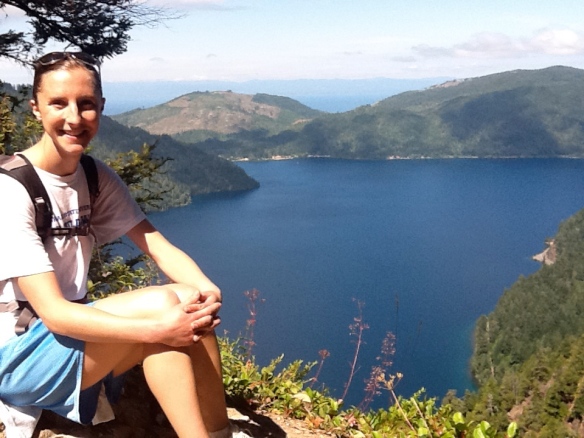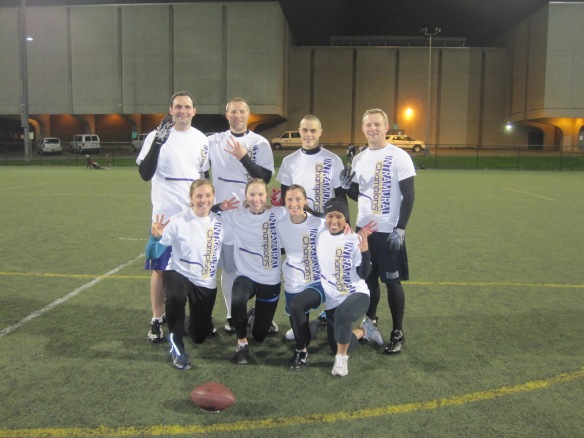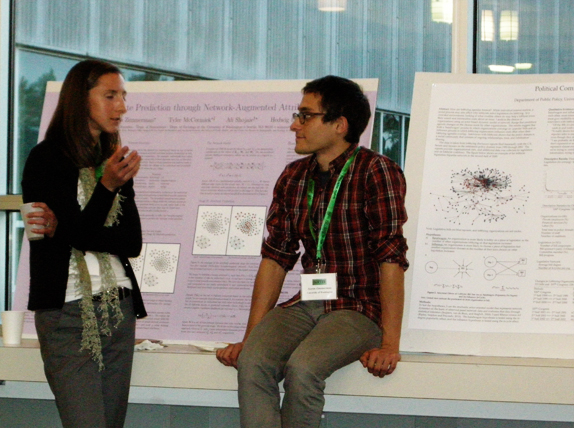“When most people think of social networks, they immediately think of interactive sites on the Internet. They assume I am studying Facebook and Twitter and I have to explain it is like that but on a much smaller scale,” said Bailey Fosdick, SAMSI postdoc. However, the social networks that Bailey is studying have nothing to do with the Internet. She is looking at scenarios such as how substance abuse and obesity of adolescents are related to their social networks and how baboon troops socialize and fission over time.
Bailey was born and raised in the small town of Steamboat Springs, Colorado, which most people identify as a ski resort town. She spent six years ski racing but finally decided to focus on basketball realizing the color of the ribbon she won in races was more important to her than the actual place (She wouldn’t hesitate to trade a brown 8th place ribbon for a pale blue 10th place one!). She said people are often surprised to find out she grew up there because they only think of it as a ski resort. After high school, she spent a year at the Colorado School of Mines, a small school located in Golden, Colorado, specializing in engineering and science. She quickly discovered that while she enjoyed the science and problem solving, she hated the labs. It was then that she decided to get into mathematics.
She rounded out her undergraduate time at Colorado State University (CSU) majoring in mathematics with a minor in computer science. During the summer between her junior and senior year, she spent time at North Carolina State University participating in their Applied Mathematics REU program and eating at Cook Out on the weekends. While she enjoyed her introduction to research through the REU, she really felt statistics was her calling and was urged to pursue graduate school by a great group of faculty mentors in the Department of Statistics at CSU. One year later she was in the statistics graduate program at the University of Washington in Seattle.
The University of Washington’s Center for Statistics and the Social Sciences gave Bailey a place to learn about important statistical questions in the social sciences. She enjoys working on real-world problems and collaborating with experts in specific areas of science to develop and apply statistical methods to solve pressing problems in their areas. For her dissertation, titled ” Modeling heterogeneity within and between arrays,” Bailey worked closely with a sociologist and she also worked on a large project involving demographers during her time at the University of Washington.
Bailey’s love for sports continued at the University of Washington where she was apart of intramural co-ed volley and coed-flag football championship winning teams multiple years. She also played co-ed softball but her team was never able to finish the season with a win.
She heard about SAMSI after seeing an advertisement announcing that SAMSI was looking for postdoctoral fellows and several of the faculty told her it would be a great opportunity to pursue. She is here for one year as a fellow for the Computational Methods in Social Sciences program. “I felt the SAMSI program was a great fit for the work I had been doing at the University of Washington,” said Bailey.
Bailey is involved with several working groups including social networks, censuses and surveys, and the topology working group, which is actually a part of the Low-dimensional Structure in High-dimensional Systems (LDHD) program.
“I have really enjoyed being here. This region is rich in opportunities with the three major universities located so close together. Although I have yet to visit all three statistics departments, the events at SAMSI have allowed me to meet and engage with many of the incredible researchers in the area,” noted Bailey.
Bailey has started a number of projects since arriving. She is working with David Banks at Duke University on a project involving Baboon social structures and helping to develop models to predict how baboon troops will split. Usually the troops split according to matrilineage, but then a troop split was observed that did not follow either the mother or father’s line.
Another project Bailey is working on is to analyze bike sharing data in Washington, D.C. Many big cities have bike sharing programs where a person will check out a bike on one place and then check it back in at another part of the city. The study is looking at how the flow of bikes throughout the city changes by day of the week, time of day, and for regular versus infrequent riders.
She has found social network research to be very interesting and fulfilling. She is also happy to be making new connections at SAMSI with whom she will most likely continue to collaborate with in the coming years.
When she is not at SAMSI, Bailey enjoys running. She says while in Seattle she usually ran when the sun was out and that typically equated to a couple times of week. However, she has found that to be a nearly daily occurrence in North Carolina. She and her husband are also playing softball in a softball league on the weekends.
Next year, Bailey will take a job as assistant professor of statistics at Colorado State University. She is happy to be returning to her home state and is very thankful that the university allowed her to take this year to do the postdoctoral fellowship at SAMSI.



